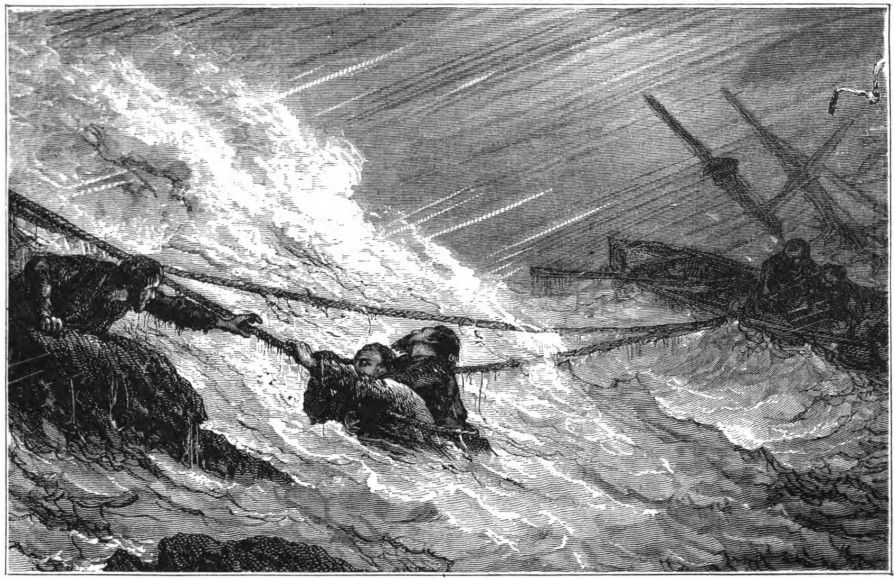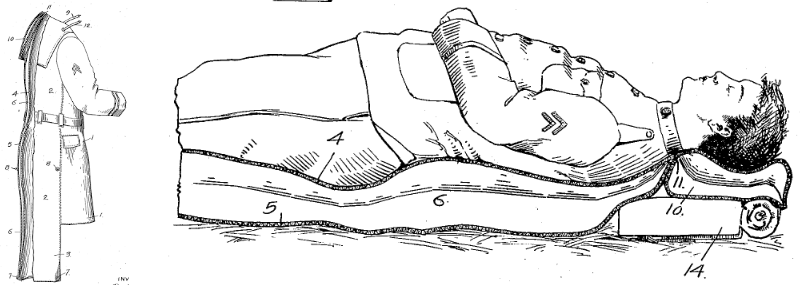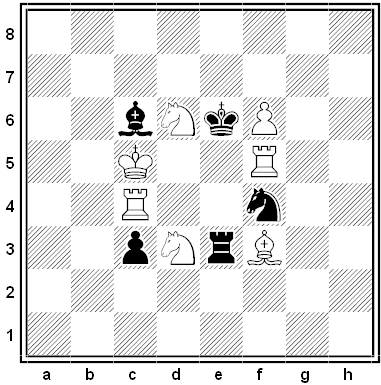Podcast Episode 355: The Auckland Islands Castaways

In 1864, two ships’ crews were cast away at the same time on the same remote island in the Southern Ocean. But the two groups would undergo strikingly different experiences. In this week’s episode of the Futility Closet podcast we’ll tell the story of the Auckland Islands castaways and reflect on its implications for the wider world.
We’ll also consider some fateful illnesses and puzzle over a street fighter’s clothing.
The Perfect Box

Certainly rectangular cuboids exist whose edges and face diagonals all have integer lengths.
For example, in 1719 Paul Halcke discovered one with edges (a, b, c) = (44, 117, 240) and face diagonals (d, e, f ) = (125, 244, 267).
But does one exist whose space diagonal (here shown in red) also has integer length?
As of last September, none has been found and no one has proven that none exist.
A Portable Bed

In 1919, Mrs. Ray Werner patented a military overcoat with an inflatable lining:
The primary object of my invention is to provide a garment, the back of which may be inflated to provide a resilient support for the body of the wearer without removing the garment, thus providing a greater comfort while reclining in a recumbent position.
A separate compartment can be inflated into a pillow. The application was granted that September; I don’t know whether it was ever manufactured.
Footwork
Devised in 1948 by Russian choreographer Nadezhda Nadezhdina, the “floating step” of the Beryozka Dance Ensemble seems to carry dancers smoothly across the stage, as though their feet have left the ground.
“Not even all our dancers can do it,” Nadezhdina said. “You have to move in very small steps on very low half-toe with the body held in a certain corresponding position.”
Self-Improvement

I send you a photo of myself for ‘Curiosities’ studying Virgil in a peculiar position. It was taken by my brother in the country a few weeks ago. It was not a snap-shot, but a time exposure.
— Charles E. Williams of Rock Ferry, Cheshire, in Strand, September 1905
Real Time
For his 2010 film The Clock, video artist Christian Marclay compiled hundreds of movie and television clips that feature clocks or timepieces. He arranged these in order and set the total running time to 24 hours, so the piece itself functions as a clock — if it’s started at the right moment and run as a loop, the time references on the screen will correspond to the correct time in the theater.
Some oddities: There’s no clock face shown at 2:50 a.m. — instead a character in Night of the Living Dead says, “It’s ten minutes to three.” In his review in the Guardian, Peter Bradshaw notes that there are droll shots of sundials in period movies. And “There is an ambiguous moment from Easy Rider in which Peter Fonda looks at his watch (showing 11:40am) and throws it away. It appears to have stopped.”
The film toured art museums for eight years, finishing in 2017 in São Paulo.
For the Record
When a tornado struck Mayfield, Ohio, in 1842, Western Reserve College mathematician Elias Loomis noticed that several fowl had been picked almost clean of their feathers. To find out what wind velocity could accomplish this, he charged a cannon with 5 ounces of gunpowder and inserted a freshly killed chicken in place of a ball:
As the gun was small, it was necessary to press down the chicken with considerable force, by which means it was probably somewhat bruised. The gun was pointed vertically upwards and fired; the feathers rose twenty or thirty feet, and were scattered by the wind. On examination they were found to be pulled out clean, the skin seldom adhering to them. The body was torn into small fragments, only a part of which could be found. The velocity is computed at five hundred feet per second, or three hundred and forty one miles per hour. A fowl, then, forced through the air with this velocity, is torn entirely to pieces; with a less velocity, it is probable most of the feathers might be pulled out without mutilating the body.
“If I could have the use of a suitable gun I would determine this velocity by experiment,” he ended. “It is presumed to be not far from a hundred miles per hour.”
(Elias Loomis, “On a Tornado Which Passed Over Mayfield, Ohio, February 4th, 1842,” American Journal of Science 43:2 [July-September 1842], 278-301.)
The Paradox of the Just Law
How can a just law have a claim on our obedience? Murder is wrong, regardless of what the law says about it; we expect people to refrain from murder because it’s wrong, not because it’s prohibited or punished. I’d be offended if someone suggested that it’s only respect for the law that’s restraining me from committing murder. But this suggests that we don’t have an obligation to obey laws that prohibit murder — a morally conscientious person should never find himself obliged to submit to them.
“The more just and valuable the law is … the more reason one has to conform to it, and the less to obey it,” writes legal philosopher Joseph Raz. “Since it is just, those considerations which establish its justice should be one’s reasons for conforming with it, i.e., for acting as it requires. But in acting for these reasons one would not be obeying the law, one would not be conforming because that is what the law requires.”
(Note, though, that Raz says the paradox is only apparent — see his full paper here.)
(Scott Hershovitz, “The Authority of Law,” in Andrei Marmor, ed., The Routledge Companion to Philosophy of Law, 2012.)
Shared Birthdays
Famously, in a group of 23 randomly chosen people, the chance is slightly higher than 50 percent that two will share a birthday.
In 2014, James Fletcher considered the birth dates of players in the World Cup, who were conveniently organized into squads of 23 people each. He found that 16 of the 32 squads had at least one shared birthday. If data from 2010 World Cup was included, 31 of 64 squads had shared birthdays, still quite close to 50 percent.
If a group numbers 366 people, the probability of a shared birthday is 100 percent (neglecting leap years). But to reach 99 percent certainty we need only 55 people. “It is almost unbelievable that such a small difference between the probabilities 99% and 100% can lead to such a big difference between the numbers of people,” writes Gabor Szekely in Paradoxes in Probability Theory and Mathematical Statistics (1986). “This paradoxical phenomenon is one of the main reasons why probability theory is so wide-ranging in its application.”

